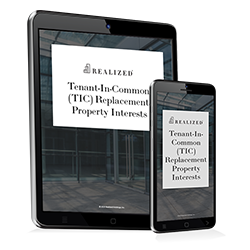
Forming a limited liability company can come with several pros and cons for real estate investors.
One of the most important benefits is the personal liability protection afforded to LLC members – owners’ personal assets are protected from creditors seeking to collect any debt incurred by the LLC’s business. Members also collectively share in the LLC’s day-to-day decision-making – much the same as with a tenant-in-common (TIC) ownership arrangement. Another similarity is that ownership in an LLC can be in unequal percentages just like with a tenants-in-common.
Investors have asked whether an LLC can invest in a TIC. Read on to learn more.
TIC Ownership and Limited Liability Companies
Joint ownership is a common way to hold title to real estate, especially for high-cost real property that’s beyond the financial reach of solo investors or owners. Real estate investors often form limited liability companies to separate their investment assets from their personal assets. Single or multi-member LLCs also enable the business rather than the individual(s) to be taxed, often at a lower rate.
Tenants-in-common is a different form of property co-ownership that comes with some distinct rules. Among them:
- Each co-owner has a separate and undivided interest in the asset.
- There’s no right of survivorship – ownership interests are passed on to an heir of your choosing rather than the other tenants if one co-owner dies.
- Co-owners are free to sell or transfer their ownership interests in the property without consent from other owners.
Co-owners who hold interests in a TIC also face the prospect of unlimited personal liability since their ownership interests are typically titled and recorded in their own names. Co-owners may purchase liability insurance, but financial ruin could still be a mere accident away if a judgment exceeds liability limits.
One way for TIC owners to avoid this unfavorable scenario is to form single-member LLCs. This ownership structure provides liability protection against any financial obligations incurred by the property. TIC owners’ risk parameters, therefore, are limited to just the funds they’ve invested in the LLC. While not common, it’s one way for an LLC to invest in a tenants-in-common ownership arrangement. It also does not overly complicate tax reporting requirements since LLCs are pass-through entities and real estate profits or losses are reported at the individual taxpayer level.¹
IRS Treatment of TICs
Tenant-in-common co-owners must adhere to a strict set of guidelines established by the IRS or they could face reclassification as a business entity instead of a TIC.
There are 15 factors that the IRS has laid out in revenue procedures that provide pretty clear guidance on how TIC ownership structures must be formed and function. Foremost among them:
- TIC co-owners must hold title as tenants-in-common
- There can be no more than 35 co-tenants
- Co-owners cannot file a corporate tax return, conduct business under a common name, or identify as a partnership or shareholders of a business entity
- Co-owners must unanimously approve important business decisions, such as hiring a property manager or signing a new lease
- Co-owners share in profits and capital expenditures on a pro-rata basis
There are many other stipulations as well, which can make TIC ownership legally complex.
The Bottom Line
Forming a single-member LLC prior to investing in a tenant-in-common property can be a simple way for real estate investors to limit their financial obligations in a multi-property portfolio. Ownership interests are segregated, so any adverse factors that affect one property won’t impact ownership interests or compromise the values of your other assets – think of it as an extra layer of insurance against financial liability.
TIC ownership must follow a lengthy list of IRS rules and guidelines. Prior to making a TIC investment, either as a co-owner or as an LLC, be sure to discuss ownership structures with an experienced tax professional to help make sure you adhere to all IRS guidelines regarding tenants-in-common.
Source:
1. Joint Ownership and Its Challenges: Using Entities to Limit Liability, AUSPL-Atlanta, https://auspl.com/wp-content/uploads/2017/05/160428.Joint_.Ownership.Entities.Liability.Article.pdf



